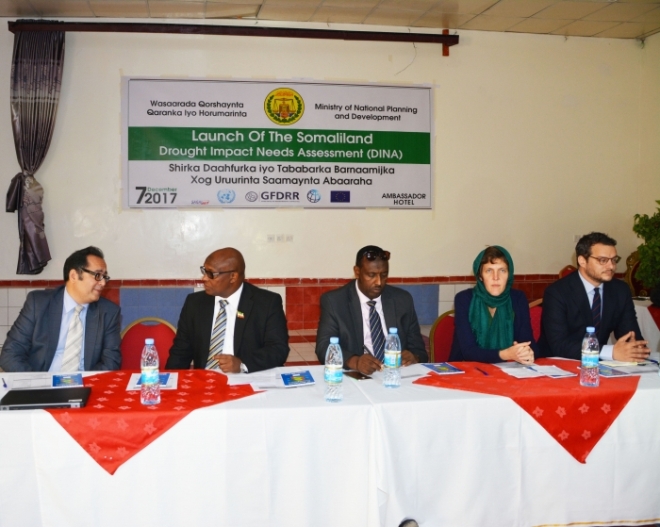Somaliland authorities are carrying out a “ Drought Impact Needs Assessment” (DINA), based on a globally recognized methodology, that is identifying long term solutions to recurrent cycles of drought, which are to be delivered in parallel to life saving humanitarian relief.
The DINA is being led by the Somaliland Government and supported by the World Bank, the European Union (EU) and the United Nations (UN). At a meeting in Hargeisa last week, attended by Government officials and representatives from the international community, participants discussed how the methodology will be applied to break the cycle of recurrent emergencies, mitigating the risk of famine.
Cyclical drought and subsequent famine risk has resulted in millions of people in need of humanitarian assistance and hundreds of thousands displaced across the country. Somaliland is however at a critical juncture where it may be able to break the cycle of such recurrent crisis, as it has continued to build stronger, inclusive and more effective institutions.
It has also made considerable democratic gains, including a recent 2017 peaceful presidential electoral process carried out in a democratic manner.
The DINA methodology has been used around the world to assist countries recover and build resilience to crises such as recurrent drought and famine risk, while at the same time ensuring the delivery of life saving humanitarian assistance.
The exercise in Somaliland is assessing the damage and losses due to drought and is building on data that has already been gathered by government authorities in partnership with the UN and NGOs. It is being carried out in alignment with the priorities of the recently launched National Development Plan II (NDPII).
The findings of DINA will inform the development of a Recovery and Resilience Framework (RRF), situated within the NDP II. The RRF will detail long-term plans for the financing and implementation of recovery interventions identified in the DINA, and will recommend policy measures required to support resilient recovery, which will be implemented in parallel to and in complementarity with humanitarian relief.
Speaking at the meeting in Hargeisa, H.E. Mohamed Ibrahim, Minister of National Planning and Development for Somaliland, reiterated the government’s strong commitment to the assessment and to the development of the Recovery and Resilience Framework. “Recurrent drought has caused extreme hardship to people in Somaliland. It is our aim that the DINA and RRF process will help us to better respond to such crises,” he said.
H.E. Hussein Abdi Boss, Somaliland Minister of Water and Natural Resources, underlined the need to reduce the risk and impact of droughts on the Somaliland population. “We welcome the DINA/RRF exercise and we ask for particular focus on the lack of access to water, as a major cause of loss of livelihoods,“ he said.
The Somaliland Minister of Education and Higher Studies, H.E. Abdullahi Habane, said that it was important to invest not only in physical capital but in social capital, to increase resilience amongst the population. “The key to building resilience in Somaliland is a vibrant economy so that government revenues can support critical services such as education and health,” he added.
Ms. Pauline Gibourdel of the European Union, congratulated the Somaliland government for its leadership in carrying out the globally recognized DINA and RRF exercises. “The DINA and RRF are a very effective and internationally recognized system used to identify the best practices to mitigate and respond to crises and build resilience,” she said.
Mr. Matthias Mayr, speaking on behalf of the World Bank, reiterated that the DINA and RRF exercises are adding to the substantial existing data gathered by government and development partners and will help to mobilise the resources needed to implement development priorities. “With the findings of DINA, we can support the priorities of the National Development Plan and identify the investment opportunities in Somaliland that can reduce the impact of recurrent drought,” he said.
Mr. Sultan Hajiyev of the United Nations Development Programme (UNDP), underlined that the DINA/RRF aims to harness development expertise to break the vicious cycle of recurrent emergencies, while delivering and supporting parallel crucial life-saving operations.
“The findings of the DINA and RRF exercises will pinpoint and provide the momentum to deliver needed long term interventions in line with the government’s development priorities, and in complementarity with humanitarian relief,” he said.
The final DINA assessment report and the launch of the Recovery and Resilience Framework are due in early 2018.
![]()




























